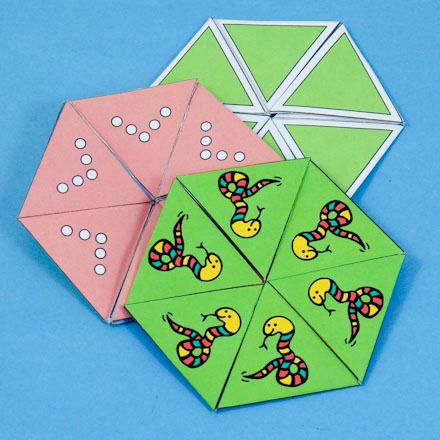

Learn how to make a really fun geometric toy—a six-sided, six-faced flexagon called a hexa-hexaflexagon! It looks like an ordinary, two-dimensional, paper hexagon with a front and a back, but hidden inside are four more sides (or faces) that become visible by flexing the paper.
There are many types of flexagons. The names of flexagons tell the type of polygon and the number of faces. In this project we make a hexa-hexaflexagon—a six-sided polygon (hexagon) with six faces (hexa).
Related crafts: For other (and easier to make) versions of the flexagon, try a tri-hexaflexagon, tetra-hexaflexagon, penta-hexaflexagon or a tri-tetraflexagon. For more about the history of flexagons, see the Flexagons project.
Share this craft with friends and family




Choose a hexa-hexaflexagon to make. Download and print the pattern.
Choose a design that prints in color, or select one of the black and white patterns and use your creativity to add color and designs.
It is easiest to fold patterns that have numbers or counting dots. Make one of these flexagons first before trying any of the others. To aid in folding and decorating the blank patterns, guides that number the faces are included on the patterns.
Numbered B&W Counting Dots Blank Inset Triangles Triangles Numbered Bright Colors Bright Numbered Animals · NumberedPatterns are Adobe PDF files. The Adobe Reader is available for free.
All of Aunt Annie's project patterns are designed to be printed on standard letter-size paper (8.5"x11" or A4). When printing from Adobe Reader, you may need to select Auto-Rotate and Center or Choose paper source by PDF page size to ensure the best fit.
Step 2: Color Pattern (optional)
Color the pattern template as you like with markers, colored pencils or crayons. You don't need to color the glue tabs marked with '*'.
Tip: On blank patterns, follow the Coloring Guide. All the triangles that make up a hexagon face have the same number, so color and decorate them with that in mind.
Cut around the two pattern pieces on the outline. Try to make the cuts very straight and accurate. There will be two pieces with 19 triangles each.
Step 4: Double and Glue
Make a double thickness by folding each pattern piece in half lengthwise and glue. To make a sharp, straight fold, first score on the fold line. Join the two pieces of the hexa-hexaflexagon together to form a strip of 19 triangles. Glue the strips together by gluing the single triangles together, back-to-back.
To score: Use a ruler and the empty ballpoint pen (or bone folder) to make an indent along the fold lines.
Score and fold back and forth on all the solid lines. Do this for each of the 19 triangles of the hexa-hexaflexagon.
The following instructions for folding the flexagon assume you are using the Numbered pattern or that each triangle of the flexagon strip is labeled with 1, 2, 3, 4, 5, or 6 per the Numbered pattern.
Place the strip of 19 triangles with the side with 6s, 5s, and 4s face up and the glue tab, *, to the left (FIGURE 1). See illustration for how the reverse side of the strip looks.
Fold the strip back on itself matching two 6s, then two 5s, then two 4s, on like this for the entire strip (nine folds). Now you have a strip of 10 triangles (FIGURE 2).
Place the strip with the side without glue tabs facing up and the 3 end to the left (FIGURE 2). Fold back on the line between the third and fourth triangles (2 and 1)—four 2s are together now (FIGURE 3). Fold back on the line between the next 2 and 1. Now you should be able to see five 2s (FIGURE 4). Pull the 2 forward that is behind the 3. There should be six 2s on top and a 1 to the side. Fold the 1 back (FIGURE 5).
The two glue tabs marked with '*' are now face-to-face. Glue them together. Wait for the glue to dry before flexing your flexagon.
Fold the flexagon to bring together three alternate corners of the flexagon. The top of the flexagon will pop open if there is a new face to reveal. If it doesn't pop open, flatten the flexagon and try again with the other three corners.
As you flex the flexagon in this project, see if you can find all the possible combinations of faces. The hexa-hexaflexagon has six faces with 3 different arrangements each, for a total of 18 possible faces. Only 15 of the faces versions can be seen with the straight strip pattern for a hexa-hexaflexagon. Can you find all 15 possibilities?

That's it! Your flexagon is done!